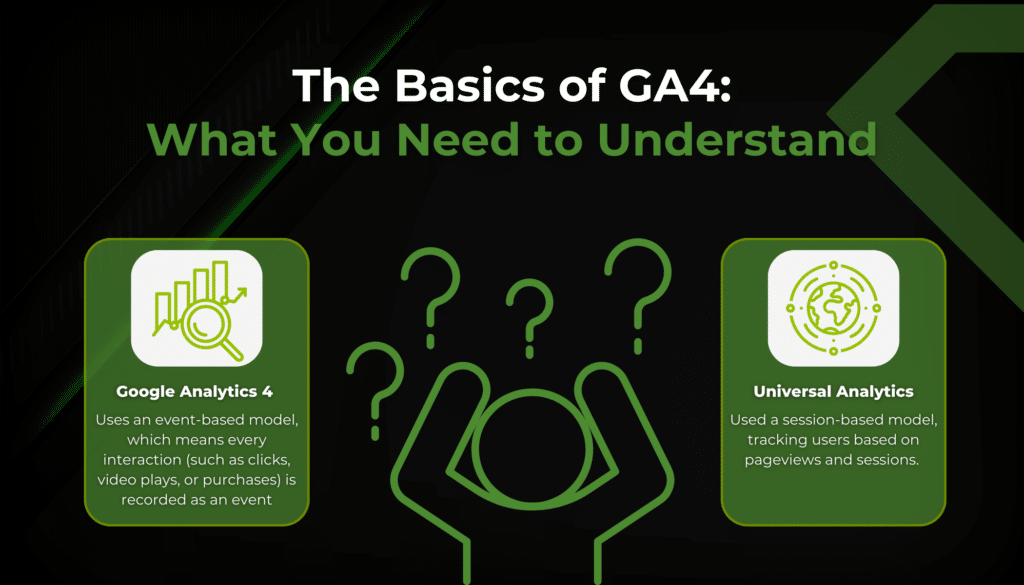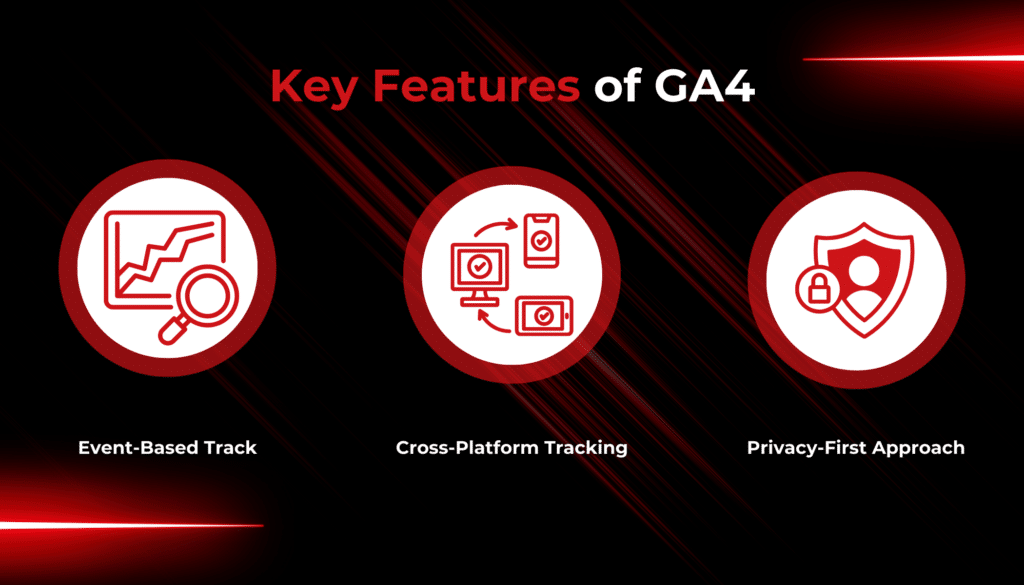Understanding GA4 Basics
Google Analytics 4 (GA4), launched in October 2020, is the newest version of Google’s analytics platform, designed to help businesses track and understand user behaviour more effectively. Unlike its predecessor, Universal Analytics (UA), GA4 introduces a new way of measuring data, making it more flexible, accurate, and future-proof.
If you rely on website traffic, you need to understand GA4. Whether you want to track how visitors interact with your site, measure conversions, or improve your marketing strategy, GA4 helps you make smarter decisions.
In this post, we’ll walk you through GA4 basics, including how it’s different, common challenges, and how it can benefit your brand.
New to GA4? Check out Everything You Need to Know About GA4 for a more detailed overview of Google Analytics 4 basics!
What is GA4?
GA4 replaces Universal Analytics as Google’s default measurement tool for websites and apps. It was developed to adapt to the changing digital landscape, where users interact with brands across multiple devices and platforms.
How GA4 Differs from Universal Analytics
The biggest difference between GA4 and UA is how data is collected and reported.
- Universal Analytics (UA) used a session-based model, tracking users based on pageviews and sessions.
- GA4 uses an event-based model, which means every interaction (such as clicks, video plays, or purchases) is recorded as an event, providing more detailed insights into user behaviour.
This shift allows GA4 to:
- Track user interactions more accurately across multiple devices
- Provide more flexibility in analysing user journeys
- Offer deeper insights through machine learning and predictive analytics
Why Should Businesses Transition to GA4?
With UA now deprecated, businesses must switch to GA4 to continue collecting and analysing data. But beyond necessity, GA4 offers significant advantages too, like:
- More accurate data tracking with event-based measurement
- Improved cross-device tracking for a complete view of customer journeys
- Privacy-friendly analytics that comply with regulations like GDPR and POPIA
- Predictive insights powered by machine learning to help businesses anticipate user behaviour
Interested in getting started? Learn more about GA4 setup with Ruby Digital.

Key Features of GA4
Event-Based Tracking
Unlike UA, which relied on predefined session-based metrics, GA4 uses events to track user interactions more accurately. This means businesses can monitor:
- Page Views – When a user visits a page on your site
- Clicks – Button clicks, outbound link clicks, and call-to-action (CTA) interactions
- Conversions – Purchases, form submissions, or any other key action
This event-based system allows businesses to collect more customisable and meaningful data compared to the rigid structure of Universal Analytics.
Cross-Platform Tracking
GA4 lets brands track users across websites and mobile apps within a single property, providing a holistic view of customer interactions. This is particularly useful for businesses that:
- Have both a website and an app and need a unified tracking solution
- Want to analyse how users switch between devices before converting
- Need to measure multi-touchpoint journeys more effectively
By combining web and app data, businesses gain a more accurate understanding of customer behaviour, rather than treating each platform separately.
Privacy-First Approach
With increasing concern about data privacy and third-party cookies, GA4 has been designed with compliance in mind.
- GDPR & POPIA Compliance – GA4 aligns with modern privacy laws, offering more user control over data collection.
- Cookieless Tracking – GA4 reduces reliance on cookies while still providing businesses with accurate insights through machine learning and first-party data modelling.
- User-Centric Data Models – Instead of focusing on individual sessions, GA4 builds a broader picture of user interactions over time, improving targeting.

Understanding the GA4 Interface
One of the biggest challenges businesses face when switching to GA4 is getting familiar with its new interface! While Universal Analytics had standardised reports, GA4 introduces a more flexible, customisable dashboard.
Key GA4 Dashboard Tabs:
- Home Tab – Provides an overview of key performance data, such as active users, recent events, and traffic trends
- Reports Tab – Where businesses can access predefined reports on user engagement, conversions, and acquisition
- Explore Tab – A more advanced feature that allows businesses to build custom explorations for deeper insights
- Configure Tab – The section where businesses can set up custom events, conversions, and audience segments
Customisation Options
One of GA4’s biggest advantages is its flexibility in reporting. Brands can:
- Create custom events to track unique user actions
- Build tailored reports that align with specific business goals
- Adjust data retention settings to store historical data for longer periods
This adaptability lets you analyse data in a way that best suits your needs, rather than relying on Google’s default reports as in UA.
Key Metrics to Focus On
GA4 introduces new ways of measuring user engagement and performance. While some familiar metrics from Universal Analytics are still available, others have been replaced with more advanced, user-focused insights.
GA4-Specific Metrics
Engagement rate
Replaces bounce rate, measuring the percentage of sessions where users actively engage with your site (e.g., scrolling, clicking, or spending more than 10 seconds on a page).
Events per session
Tracks the average number of interactions per visit, helping businesses understand how engaged users are.
User retention
Measures how many users return over time, providing insights into audience loyalty.
How to Interpret These Metrics
Understanding these numbers can help businesses optimise their marketing and content strategies. For example:
- A low engagement rate may indicate that your content isn’t capturing user interest.
- A high number of events per session suggests that visitors are actively interacting with your website.
- Monitoring user retention can highlight whether customers find long-term value in your content or services.
Benefits of GA4 for Businesses
- A better understanding of user behaviour
GA4 provides deeper insights into customer journeys, tracking how users interact with content, where they drop off, and what actions lead to conversions.
- Improved data accuracy and reporting
With event-based tracking, GA4 offers more precise data collection than UA, reducing gaps and inconsistencies. Businesses can also set up custom reports tailored to their goals.
- Enhanced predictive analytics
GA4’s machine learning capabilities can forecast trends, such as which users are likely to purchase or disengage. This allows businesses to optimise their marketing efforts proactively.
- Staying competitive in a data-driven world
With increasing privacy regulations and changing user behaviours, businesses need tools that adapt to the future. GA4’s privacy-first approach ensures compliance while still providing meaningful insights.
Common Challenges and How to Overcome Them
While GA4 offers many benefits, change is always hard! Here’s how to tackle some of the most common obstacles.
Complexity of the new interface
GA4’s dashboard is different from UA, which can feel overwhelming at first. The best way to master it is through:
- Google’s free GA4 training resources
- Hands-on exploration – click around and test different reports for yourself!
- Customising reports to show only the data you need
Data discrepancies between UA and GA4
You’ll notice differences in data when comparing GA4 to UA. This happens because:
- GA4 tracks users differently (event-based vs. session-based tracking)
- Certain UA metrics (like bounce rate) have been replaced with new engagement-based ones
- GA4 includes automatic data sampling, which may differ from UA’s reporting methods
To manage expectations, focus on understanding GA4’s new data model rather than trying to match UA’s numbers exactly.

Where to Go from Here
Getting to grips with GA4 might feel like a challenge at first, but once you understand the basics, it opens up a whole new world of insights. With its event-based tracking, custom reports, and predictive analytics, GA4 isn’t just another analytics update. It’s a smarter way to understand your audience and make better business decisions.
If you’re still adjusting to the new interface or wondering how to make the most of GA4, don’t stress. Like any tool, it gets easier with time and practice. Start by exploring the dashboard, tracking key metrics, and customising reports to suit your needs.
Need help setting up GA4 for your business?
Ruby Digital’s GA4 setup service ensures your analytics are configured for success right from the get-go!



